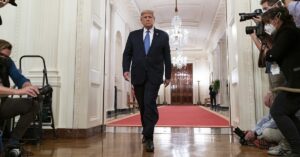White House limits access to Oval Office, Air Force One for Associated Press: Report
The White House has taken a firm step in its ongoing clash with the Associated Press by restricting their journalists' access to the Oval Office and Air Force One, The Hill reported.
This move has intensified a dispute surrounding the AP’s unwillingness to adopt the term "Gulf of America," prompting serious dialogue about press freedom and media management.
The announcement from the White House marks a significant escalation in the conflict with the Associated Press (AP) over geographic naming conventions. A disagreement began when AP refused to switch its terminology from the Gulf of Mexico to the Gulf of America, as part of recent executive administration directives. The issue came to light following a January 23 guidance from the AP about this change, igniting subsequent decisions that affected their access privileges.
AP Reporter Blocked From Oval Office Meeting
On Friday, a notable incident underscored tensions between the White House and this key news organization. An AP reporter was denied entry to cover an executive order signing in the Oval Office, despite efforts to join colleagues from other media outlets for the event. The journalist was rebuffed with a succinct response from a White House official, highlighting a growing trend of restricted access throughout the week.
The White House had previously barred AP reporters from attending a closely watched joint press conference with President Trump and India's Prime Minister on Thursday. This exclusion raised alarms, drawing condemnation from the White House Correspondents’ Association, which emphasized the importance of open media coverage in democratic societies.
The administration's actions followed a statement on Friday by Taylor Budowich, the White House deputy chief of staff. Budowich criticized the Associated Press for ignoring what he described as the “lawful geographic name change” of the Gulf area, emphasizing that while media outlets have First Amendment rights, they do not “ensure their privilege” to certain limited spaces.
Press Freedom Concerns Amidst New Policy
The AP responded to these measures with a strong stance on the principles of press freedom. An AP spokesperson highlighted the potential erosive impact of the administration's actions on constitutional rights that are fundamental to public discourse. They argued that penalizing their coverage due to editorial choices regarding geographic nomenclature undermines a core democratic principle.
Despite these access restrictions, AP journalists and photographers continue to hold their credentials for accessing the broader White House complex. This balance suggests a nuanced approach by the administration, allowing continued coverage but selectively excluding AP from high-profile areas.
Taylor Budowich further defended the White House's approach, arguing that the move was not only a response to the AP's perceived commitment to misinformation but an enforcement of the right to exclude when necessary. This sentiment underscores a broader administrative philosophy on controlling misinformation and ensuring accurate representation in privileged media contexts.
Conflict Rooted in Naming Discrepancy
The crux of the current conflict roots back to the executive order which sought to rename the Gulf of Mexico to the Gulf of America. This directive has become a focal point for discussions on the relationship between the current administration and the media, especially regarding how editorial standards are set and maintained by independent news entities.
Karoline Leavitt, another voice from within the White House communications team, referenced the "privilege to cover the White House" and suggested that outlets promoting what they deem "lies" face potential exclusion from key events. The comments opened further discussion about the responsibilities and rights of media organizations in maintaining their roles as public informants.
As the situation unfolds, observers and media professionals continue to analyze the implications of this policy shift for both immediate press coverage and longer-term governmental-media relations. The events may set a precedent for how disagreements over editorial decisions are handled by federal entities.
Repercussions For Media-Government Dynamics
In conclusion, the situation draws attention to a complicated dynamic between government authority and press freedoms, engaging fundamental issues about the First Amendment and its interpretation in contemporary media practice. With ongoing developments, both the administration and the Associated Press will continue to navigate the impacts of these decisions on their operational freedom and public perception.
The White House's shift to potentially welcome other reporters, previously barred, could hint at a strategy to manage coverage more aligned with administrative narratives while maintaining the facade of openness. This aspect will be crucial as the story progresses.
Ultimately, the restriction of the AP's access serves as a reminder of the delicate balance between ensuring a free press and managing accurate information dissemination in governmental affairs. It remains to be seen how both parties will pursue reconciliation or further entrenchment as the dispute develops.


